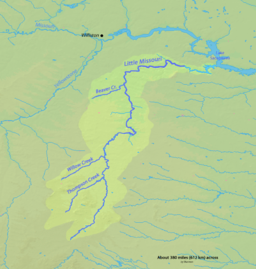Little Missouri River (North Dakota)
| Little Missouri River | |
|
Flowing through Theodore Roosevelt National Park
|
|
| Country | United States |
|---|---|
| States | Wyoming, Montana, South Dakota, North Dakota |
| Source | Flatiron Butte |
| - location | near Oshoto, Crook County, Wyoming |
| - elevation | 4,501 ft (1,372 m) |
| - coordinates | 44°32′25″N 104°59′57″W / 44.54028°N 104.99917°W |
| Mouth | Missouri River |
| - location | Lake Sakakawea, near Killdeer, Dunn County, North Dakota |
| - elevation | 1,860 ft (567 m) |
| - coordinates | 47°36′38″N 102°52′24″W / 47.61056°N 102.87333°WCoordinates: 47°36′38″N 102°52′24″W / 47.61056°N 102.87333°W |
| Length | 560 mi (901 km) |
| Basin | 8,310 sq mi (21,523 km2) |
| Discharge | for 17.5 miles (28.2 km) south of Watford City, about 25 miles (40 km) from the mouth |
| - average | 534 cu ft/s (15 m3/s) |
| - max | 110,000 cu ft/s (3,115 m3/s) |
| - min | 0 cu ft/s (0 m3/s) |
|
Little Missouri watershed
|
|
The Little Missouri River is a tributary of the Missouri River, 560 miles (901 km) long, in the northern Great Plains of the United States. Rising in northeastern Wyoming, in western Crook County about 15 miles (24 km) west of Devils Tower, it flows northeastward, across a corner of southeastern Montana, and into South Dakota. In South Dakota, it flows northward through the Badlands into North Dakota, crossing the Little Missouri National Grassland and both units of Theodore Roosevelt National Park. In the north unit of the park, it turns eastward and flows into the Missouri in Dunn County at Lake Sakakawea, where it forms an arm of the reservoir 30 miles (48 km) long called Little Missouri Bay and joins the main channel of the Missouri about 25 miles (40 km) northeast of Killdeer.
The highly seasonal runoff from badlands and other treeless landscapes along the Little Missouri carries heavy loads of eroded sediment downstream. The sedimentary layers, which extend from the headwaters in Wyoming all the way to the mouth in North Dakota, vary in age, but most of the beds along the river belong to the Bullion Creek and Sentinel Butte formations, both deposited during the Paleocene (about 66 to 56 million years ago). The deposits include siltstone, claystone, sandstone, and lignite coal laid down in a coastal plain during the Laramide orogeny.
...
Wikipedia



